Last Updated on March 10, 2024 by TheMealPrepNinja
Are you tired of spending too much money on eating out or ordering takeout? Do you struggle to find the time to cook healthy meals during the week? If so, it’s time to discover the wonders of budget-friendly meal prep for beginners!
By learning the art of meal prepping, you can save both your wallet and your waistline. But where do you start? How do you create affordable meal plans and find easy recipes that won’t break the bank?
Let’s explore the world of budget-friendly meal prep together and unlock the secrets to delicious and nutritious meals without draining your savings.
Key Takeaways:
- Meal prepping can save you time and money by preparing meals in advance.
- Creating a budget-friendly meal plan is essential for successful meal prepping.
- Evaluating and purchasing the right meal prep containers can help you stay organized.
- Smart grocery shopping strategies can help you save money on ingredients.
- Efficient cooking techniques and proper storage can maximize the freshness of your prepped meals.
This post may contain affiliate links, which means we may receive a commission, at no extra cost to you, if you purchase through a link.
Understanding the Basics of Meal Prepping
Meal prepping involves preparing meals or recipes in advance and portioning them out for future consumption. It is a way to streamline the cooking process and have ready-made meals on hand for easy and convenient eating. Meal prepping can help save time, money, and reduce food waste in the kitchen.
What Is Meal Prepping and Why Do It?
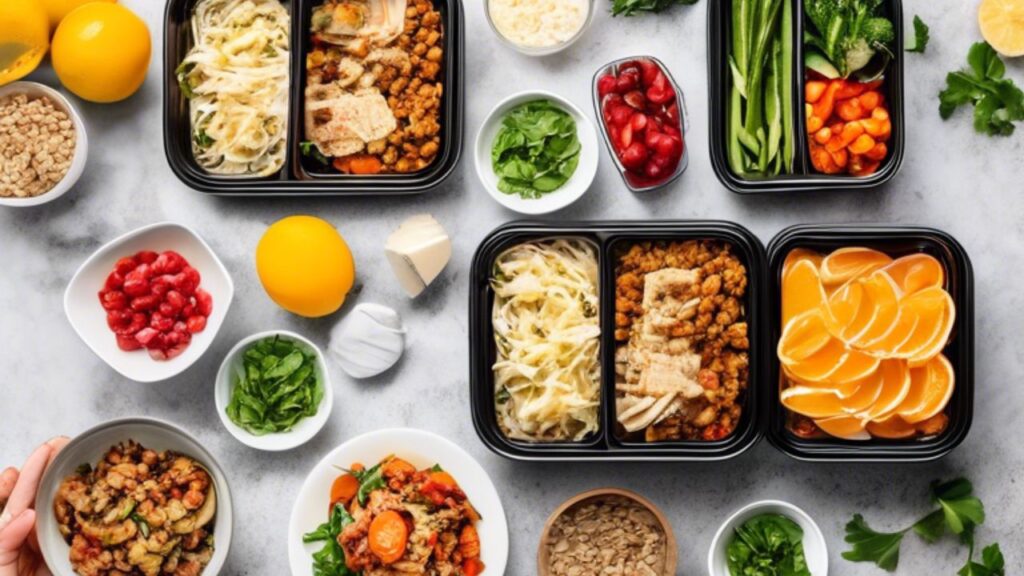
Meal prepping is the practice of planning and preparing meals ahead of time, typically for the week. It involves cooking and portioning out meals into individual containers, which can then be refrigerated or frozen until ready to eat.
The purpose of meal prepping is to save time and effort during the week by having pre-made meals readily available. It also allows for better portion control and the ability to choose healthier ingredients.
The Benefits of Meal Prepping: From Wallet to Waistline
Meal prepping offers numerous benefits for individuals and families. Here are some of the key advantages:
- Time-saving: Meal prepping eliminates the need for daily cooking and reduces time spent in the kitchen. With pre-prepared meals, you can simply heat and eat, saving valuable time during busy weekdays.
- Cost-saving: By planning meals in advance and buying ingredients in bulk, meal prepping can help save money on groceries. It also reduces the temptation to eat out or order takeout, which can be more expensive.
- Healthier eating: With meal prepping, you have control over the ingredients and portion sizes in your meals. This allows you to make healthier choices and maintain a balanced diet.
- Reduced food waste: Meal prepping helps minimize food waste as you only cook and portion out what you will actually eat. It also allows for proper storage and organization of leftovers.
Identifying Your Meal Prep Style and Goals
When it comes to meal prepping, it’s important to identify your meal prep style and goals. This will help you tailor your meal prepping strategy to your specific needs. Here are a few factors to consider:
- Meal prep style: Determine whether you prefer to prep all your meals for the week or focus on prepping certain meals or ingredients.
- Meal prep goals: Consider your goals for meal prepping, such as saving money, eating healthier, or having more time during the week. These goals will guide your meal planning and prep techniques.
- Time-saving meal prep techniques: Explore different time-saving techniques, such as batch cooking, using kitchen gadgets, or utilizing leftovers creatively to maximize efficiency.
- Cost-saving meal prep strategies: Look for ways to save money on groceries, such as planning meals around budget-friendly ingredients, shopping sales and discounts, or buying in bulk.
By identifying your meal prep style and goals, you can create a customized meal prepping routine that works best for you, helping you save time, money, and hassle in the kitchen.
Creating Your Budget-Friendly Meal Plan
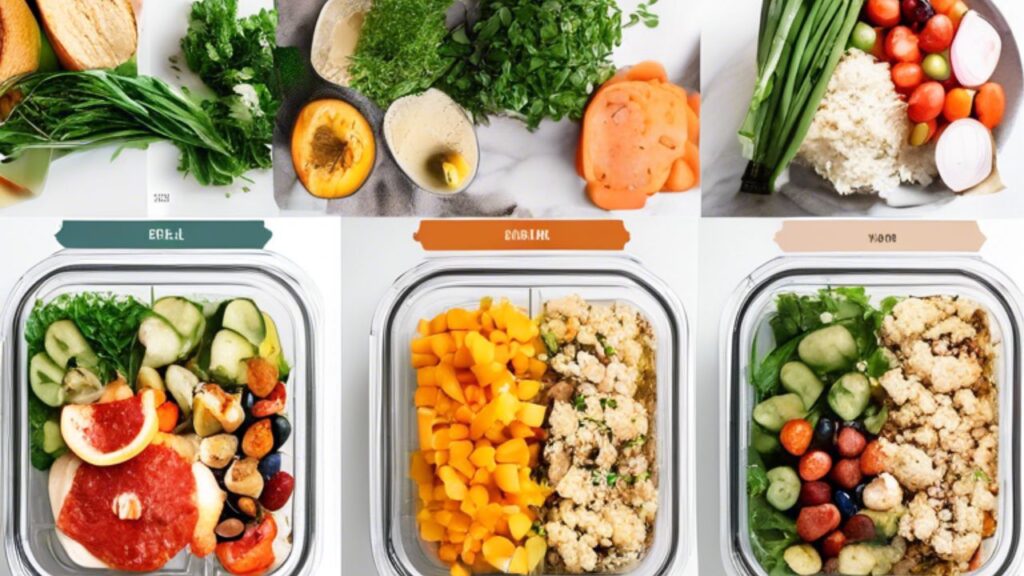
Creating a budget-friendly meal plan is crucial when it comes to successful meal prepping. By strategically planning your meals for the week based on your budget, dietary needs, and personal preferences, you can ensure that you have delicious and nutritious meals while saving money. Here are some tips to help you create a budget-friendly meal plan:
- Determine the number and types of meals: Start by deciding how many meals you need to prepare and what types of meals you want to include, such as breakfast, lunch, dinner, and snacks.
- Incorporate affordable ingredients: Look for affordable ingredients that fit within your budget. Consider using seasonal produce, as it tends to be less expensive and more flavorful.
- Shop for items on sale or in bulk: Keep an eye out for sales and discounts on ingredients you use frequently. Buying in bulk can also help you save money in the long run.
- Aim for a balanced meal plan: Include a variety of nutrients and flavors in your meals. Make sure to incorporate vegetables, fruits, whole grains, lean proteins, and healthy fats for a well-rounded and satisfying meal plan.
- Choose recipes that can be easily scaled: Look for recipes that can be easily scaled up or down depending on the number of servings you need. This way, you can adjust the quantities based on your meal plan.
By following these tips and creating a budget-friendly meal plan, you can ensure that you have all the necessary ingredients, minimize food waste, and save money on groceries.
| Meal | Recipe | Cost per Serving |
|---|---|---|
| Breakfast | Vegetable omelet | $1.50 |
| Lunch | Quinoa salad with roasted vegetables | $2.00 |
| Dinner | Chicken stir-fry with brown rice | $2.50 |
The table above provides an example of a budget-friendly meal plan. It includes a vegetable omelet for breakfast, a quinoa salad with roasted vegetables for lunch, and a chicken stir-fry with brown rice for dinner. Each meal has an estimated cost per serving to help you stay within your budget.
Evaluating and Purchasing Budget Meal Prep Containers
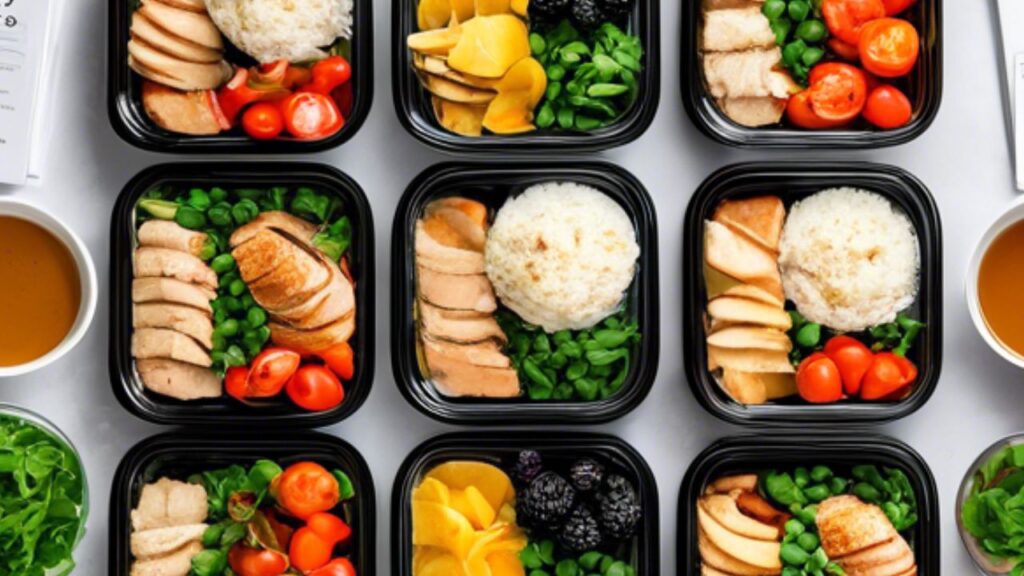
Starting with Cost-Effective Container Options
Having the right containers is essential for effective meal prepping. When starting out, it’s important to consider budget-friendly options that meet your needs. One popular choice for budget meal prep containers is reusable plastic Ziploc containers. These containers are not only affordable but also BPA-free, freezer-safe, dishwasher-safe, and microwave-safe, making them convenient for meal prepping and reheating meals. They come in a variety of sizes and shapes, allowing you to portion out your meals easily. While they may not be as durable or environmentally friendly as some other options, they are a great starting point for beginners on a budget.
Graduating to Sustainable and Durable Solutions
As your budget allows, you can gradually upgrade to more sustainable and durable meal prep containers. Glass containers, such as those offered by Pyrex, are a popular choice among experienced meal preppers. Not only are they more durable and long-lasting, but they are also non-toxic and better for the environment.
Glass containers can easily be reheated in the microwave or oven and can withstand temperature changes without warping or cracking. They are also dishwasher-safe, making clean-up a breeze. Metal bento-style containers are another option to consider, especially for cold meals that don’t require reheating. They are durable, lightweight, and often come with separate compartments for easy organization.
When it comes to smaller portions or dressings and dips, using fold-top sandwich bags or small resealable containers can be a cost-effective solution. These options are perfect for separating ingredients and keeping them fresh until you’re ready to use them.
Choosing the right meal prep containers will not only help keep your prepped meals fresh and organized but also make them easy to transport. Whether you opt for budget-friendly plastic containers or upgrade to more sustainable options, find containers that fit your needs and budget to ensure a successful meal prepping experience.
Smart Grocery Shopping Strategies
Smart grocery shopping is an essential component of budget-friendly meal prep. By employing strategic shopping strategies, you can save money, stick to your budget, and ensure that you have all the ingredients you need for your meal plan. Here are some tips to help you optimize your grocery shopping:
- Plan your meals: Before heading to the grocery store, take the time to plan your meals for the week. This will allow you to create a comprehensive grocery list that includes all the necessary ingredients. By planning ahead, you’ll avoid making impulse purchases and ensure that you have everything you need for your meal prep.
- Look for sales and discounts: Keep an eye out for sales and discounts on the items you regularly purchase. Many grocery stores have weekly specials or offer loyalty programs that can help you save money. Consider subscribing to newsletters or downloading apps that provide information on current deals and coupons.
- Consider budget-friendly stores: Shopping at budget-friendly stores like Aldi or Trader Joe’s can be a great way to find affordable options. These stores often offer lower-priced alternatives to many name-brand items, allowing you to stretch your budget while still getting quality ingredients.
- Buy generic or store-brand products: Opting for generic or store-brand products can help you save money without compromising on quality. Many store-brand items are comparable in taste and quality to their more expensive counterparts, so don’t be afraid to give them a try.
- Check the discounted section: Take a moment to browse the discounted or clearance section of the grocery store. Here, you may find deals on soon-to-expire items that can be incorporated into your meal prep. Just make sure to check the expiration date before purchasing.
- Consider purchasing in bulk: If there are ingredients that you use frequently, consider purchasing them in bulk. Buying in bulk can often lead to significant savings over time. Just make sure that the item is non-perishable or can be properly stored to avoid spoilage.
By adopting these smart grocery shopping strategies, you can stretch your budget and get the most value out of your grocery purchases. With a well-stocked kitchen, you’ll be prepared to create delicious and budget-friendly meals through your meal prep efforts.
Budget-Friendly Meal Prep for Beginners: Recipe Ideas
When it comes to budget-friendly meal prep, recipe ideas are essential. You want meals that are not only affordable but also balanced and easy to prepare in advance. Here are some recipe ideas to inspire your budget-friendly meal prep:
Balanced and Affordable Breakfast Options
Start your day off right with these nutritious and budget-friendly breakfast ideas:
- Overnight Oats: Prepare a large batch of overnight oats by combining rolled oats, milk (dairy or plant-based), and your favorite toppings like fruits, nuts, or seeds. Portion them into individual containers for a quick and easy breakfast.
- Egg Muffin Cups: These protein-packed muffin cups can be customized with your favorite ingredients. Whisk together eggs, add vegetables, diced ham or turkey, and cheese. Bake them in a muffin tin and portion them out for a grab-and-go breakfast.
- Smoothie Packs: Prepare smoothie packs by freezing pre-portioned bags of fruits and vegetables. In the morning, blend them with your choice of liquid (milk, yogurt, or juice) for a refreshing and budget-friendly breakfast.
Lunch Preps That Save Money And Time
When it comes to lunch preps, opt for affordable and packable options. Here are some ideas:
- Wraps: Make wraps with tortillas or lettuce leaves filled with your choice of protein (chicken, turkey, or tofu), vegetables, and condiments. Wrap them individually for an easy and budget-friendly lunch.
- Salads: Create hearty salads with a variety of ingredients like mixed greens, roasted vegetables, beans, and your choice of protein. Store the dressings separately to keep the salads fresh.
- Grain Bowls: Combine cooked grains, such as quinoa or brown rice, with vegetables, beans, and a flavorful sauce. Portion them into individual bowls for a filling and budget-friendly lunch.
Grilled Boneless Chicken Thigh Meal Prep
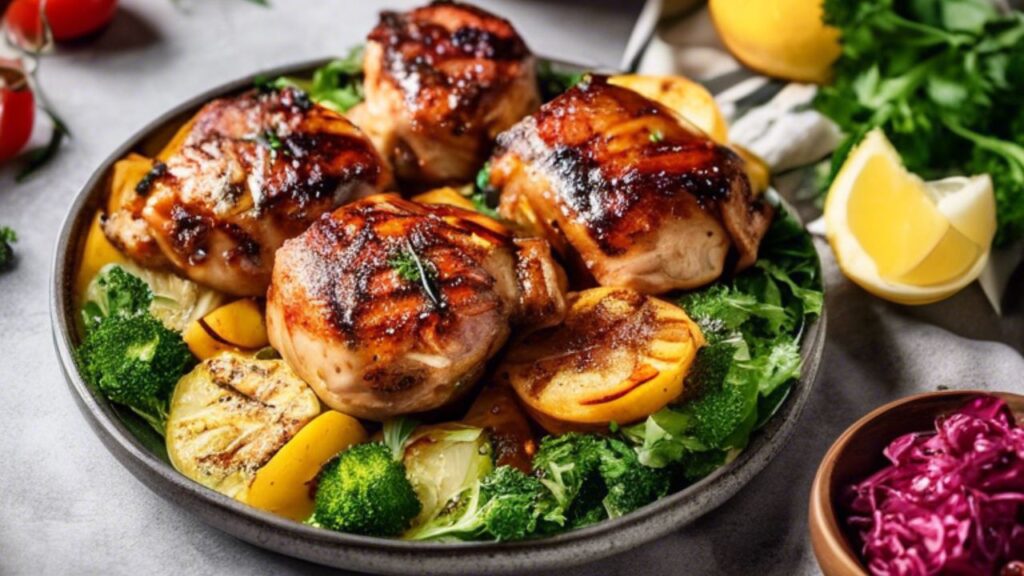
Ingredients:
- 6 boneless, skinless chicken thighs
- 2 tablespoons olive oil
- 2 cloves garlic, minced
- 1 teaspoon paprika
- 1 teaspoon dried oregano
- 1 teaspoon dried thyme
- Salt and pepper to taste
- Optional: Fresh herbs like rosemary or parsley for garnish
Instructions:
- Prepare the Marinade:
- In a small bowl, mix together the olive oil, minced garlic, paprika, oregano, thyme, salt, and pepper.
- Marinate the Chicken:
- Place the chicken thighs in a resealable plastic bag or a shallow dish.
- Pour the marinade over the chicken, ensuring each piece is evenly coated.
- Seal the bag or cover the dish with plastic wrap and refrigerate for at least 30 minutes, or up to 24 hours for maximum flavor.
- Preheat the Grill:
- Preheat your grill to medium-high heat, around 375-400°F (190-200°C).
- Grill the Chicken:
- Remove the chicken thighs from the marinade and discard any excess marinade.
- Place the chicken on the preheated grill and cook for 6-7 minutes on each side, or until the internal temperature reaches 165°F (74°C) and the chicken is no longer pink in the center.
- Rest and Serve:
- Once the chicken is cooked through, remove it from the grill and let it rest for a few minutes to allow the juices to redistribute.
- Garnish with fresh herbs if desired.
- Meal Prep:
- Once the grilled chicken thighs have cooled, divide them into meal prep containers.
- You can pair the chicken with your choice of sides such as roasted vegetables, quinoa, or a simple salad for a complete meal.
Tips and Variations:
- Flavor Variation: Experiment with different marinades or seasonings such as lemon pepper, Cajun, or teriyaki for varied flavor profiles.
- Grilling Time: Adjust grilling time based on the thickness of the chicken thighs, ensuring they are fully cooked but still juicy.
- Serving Suggestions: Consider adding a squeeze of fresh lemon juice over the grilled chicken before serving for a refreshing zing.
- Storage: Store the meal prep containers in the refrigerator for up to 4 days, making it a convenient option for quick and delicious meals throughout the week.
Dinner Solutions That Keep Both Health and Budget in Check
For dinner, focus on budget-friendly meals that are both healthy and delicious. Here are some ideas:
- Stir-Fries: Stir-fries are a great way to use up vegetables and incorporate affordable protein sources like tofu, chicken, or shrimp. Serve them over a bed of rice or noodles for a satisfying dinner.
- Casseroles: Make casseroles with affordable ingredients like pasta, vegetables, and ground meat or beans. They can be prepared in advance and stored in portioned containers for easy reheating.
- One-Pot Dishes: Create flavorful one-pot dishes like chili, curry, or soup that can be made in advance and enjoyed throughout the week. These meals are not only budget-friendly but also require minimal cleanup.
By incorporating these budget-friendly recipe ideas into your meal prep, you can enjoy delicious and nutritious meals while saving money along the way. Learn more about batch cooking.
Efficient Cooking Techniques for Meal Prep
Batch Cooking Basics
One of the most time-saving cooking techniques for meal prep is batch cooking. This method involves cooking larger quantities of food at once, which can save you time and energy throughout the week.
Instead of cooking individual meals every day, you can prepare a large batch of grains, proteins, or roasted vegetables that can be used in multiple meals. This eliminates the need for repetitive cooking and allows for faster and easier meal assembly.
Utilizing Leftovers Wisely
Another efficient technique for meal prep is utilizing leftovers wisely. Instead of letting leftovers go to waste, you can repurpose them into new meals. For example, if you have leftover roasted chicken, you can use it to make delicious sandwiches, salads, or stir-fries. By giving your leftovers a new life, you not only save time and money but also reduce food waste.
By implementing these efficient cooking techniques and utilizing leftovers effectively, you can maximize your meal prep efficiency, save time in the kitchen, and reduce food waste. These strategies are key to streamlining your meal prep process and enjoying delicious and nutritious meals throughout the week.
Storing and Preserving Your Prepped Meals
Properly storing and preserving your prepped meals is crucial to maintaining their freshness and preventing food spoilage. To ensure optimal results, follow these essential tips:
Invest in High-Quality Meal Prep Containers
Choose meal prep containers that are airtight and leak-proof to keep your meals fresh for longer. These containers provide a barrier against bacteria and help maintain the flavor and quality of your prepped meals.
Follow FDA Guidelines for Refrigeration
If you plan to store your prepped meals in the refrigerator, it’s important to follow the guidelines set by the Food and Drug Administration (FDA). Refrigerate your meals at or below 40°F (4°C) to prevent the growth of harmful bacteria and ensure food safety.
Limit Meal Prep Duration
It’s generally recommended not to prep more than four days’ worth of meals at a time. This timeframe ensures optimal freshness and quality while minimizing the risk of food spoilage.
Consider Freezing Meals
If you have meals that you won’t consume within a few days, freezing them is an excellent option. Freezing meals extends their shelf life and provides you with a variety of options to choose from throughout the week. Ensure your meal prep containers are freezer-safe and properly labeled with the date of preparation.
By implementing these storing and preserving techniques, you can ensure that your prepped meals stay fresh, nutritious, and enjoyable to eat. Preventing food spoilage not only saves you money but also promotes a healthier and more sustainable approach to meal prep.
Meal Prep Time Management: A Step-by-Step Guide
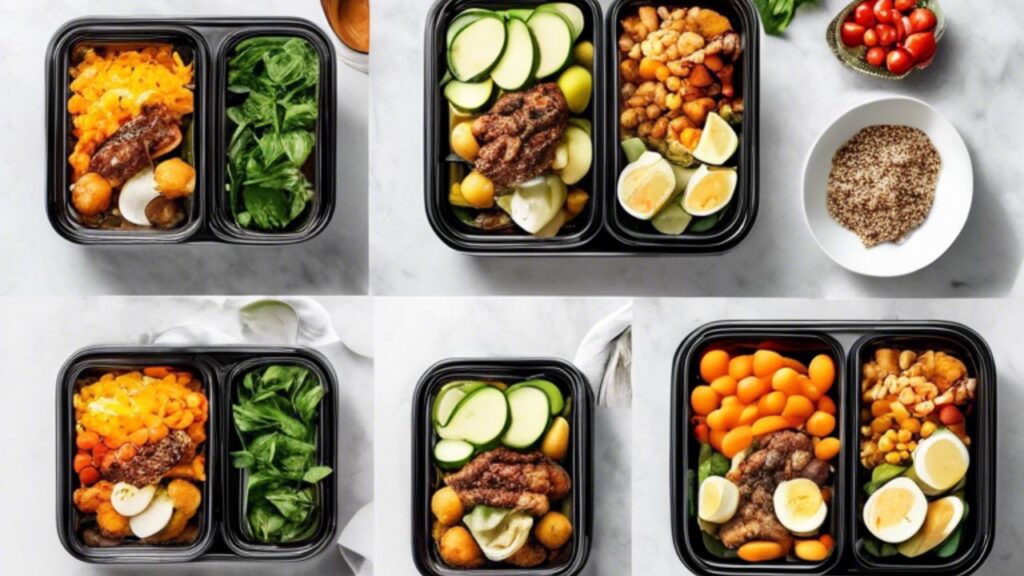
Time management is essential for efficient meal prep. By effectively managing your time, you can streamline the meal prep process and make it more manageable. In this section, I will provide a step-by-step guide to help you create an effective meal prep schedule and overcome common time constraints.
Creating an Effective Meal Prep Schedule
Creating a meal prep schedule that works for you is the first step towards efficient time management. Consider your lifestyle and schedule when planning your meal prep sessions. Set aside dedicated time each week to focus on meal planning, grocery shopping, ingredient preparation, and cooking. By allocating specific time slots for these tasks, you can stay organized and consistent with your meal prep efforts.
Here’s a breakdown of how you can create an effective meal prep schedule:
- Plan your meals: Take some time to plan your meals for the upcoming week. Decide on the recipes you want to prepare and make a list of the ingredients you’ll need.
- Grocery shopping: Schedule a time to go grocery shopping. Choose a day and time when the store is less crowded to save time and avoid unnecessary stress.
- Prep ingredients: Set aside a block of time to prepare and chop your ingredients in advance. This will help streamline the cooking process and save time when you’re ready to cook.
- Cooking: Dedicate a specific time to cook your meals. This could be a couple of hours on a weekend or a weeknight when you have more free time. Batch cook to make the most of your time in the kitchen.
- Storage: Once your meals are cooked, portion them out into your meal prep containers and store them properly in the refrigerator or freezer.
Overcoming Common Time Constraints
While meal prepping, you may encounter common time constraints that can make the process challenging. Here are some strategies to help you overcome these constraints and make the most of your time:
- Multitask while cooking: Look for opportunities to multitask in the kitchen. For example, while a dish is simmering on the stove, you can chop vegetables or wash dishes. This allows you to maximize your time and efficiency.
- Utilize kitchen gadgets and tools: Invest in time-saving kitchen gadgets and tools that can help streamline meal prep tasks. For example, a food processor can quickly chop vegetables, a slow cooker can simmer dishes while you’re away, and an instant pot can significantly speed up cooking times.
- Prep ingredients in advance: Take advantage of downtime to prep ingredients in advance. For example, if you have a few minutes in the morning, chop vegetables or marinate meat to save time later in the day.
By implementing these time management techniques, you can make the most of your meal prep sessions and ensure a smooth and efficient process.
Now that you have learned how to create an effective meal prep schedule and overcome time constraints, you are ready to take your meal prep game to the next level. In the next section, I will provide valuable tips for beginners looking to get started with budget-friendly meal prep. Stay tuned!
Budget-Friendly Meal Prep for Beginners: Getting Started
Getting started with meal prep can be daunting, especially if you’re new to the concept. However, with the right tips and strategies, you can quickly become a pro at preparing simple and inexpensive meals that fit your budget. Here are some essential tips for first-time meal preppers:
Tips for First-Time Meal Preppers
- Start small: Begin by prepping one or two meals per week to get comfortable with the process. Gradually increase the number of meals as you become more confident.
- Set realistic expectations: Understand that meal prep takes time and practice. Don’t expect perfection right away. Allow yourself to learn and improve as you go.
- Plan your meals: Create a meal plan for the week, including breakfast, lunch, dinner, and snacks. This will help you stay organized and ensure you have all the ingredients you need.
- Focus on simple recipes: Choose recipes that require minimal ingredients and preparation. This will save you both time and money. Look for budget-friendly ingredients like grains, legumes, and seasonal produce.
- Invest in quality containers: Purchase reusable meal prep containers that are durable and leak-proof. This will help keep your meals fresh and prevent any messes.
Mastering the Art of Simple, Inexpensive Meals
When it comes to budget-friendly meal prep, simplicity is key. Here’s how you can master the art of creating simple and inexpensive meals:
- Utilize pantry staples: Stock up on staple ingredients like rice, pasta, beans, and canned vegetables. These items are affordable and can be used to create a variety of meals.
- Repurpose leftovers: Make use of leftovers by transforming them into new meals. For example, leftover roasted chicken can be used in sandwiches, salads, or stir-fries.
- Opt for batch cooking: Prepare large batches of meals and portion them out for the week. This not only saves time but also allows you to take advantage of bulk discounts on ingredients.
- Get creative with seasonings: Experiment with different herbs, spices, and sauces to add flavor to your meals. This will keep your taste buds excited and prevent mealtime monotony.
- Make use of frozen produce: Frozen fruits and vegetables are often more affordable than fresh ones and can be just as nutritious. Incorporate them into your meal prep to save money without compromising on quality.
By following these tips, you’ll be well on your way to mastering the art of simple, inexpensive meal prep. Remember, the key is to start small, be consistent, and enjoy the process of cooking and saving money.
Navigating Challenges and Solutions in Meal Prep
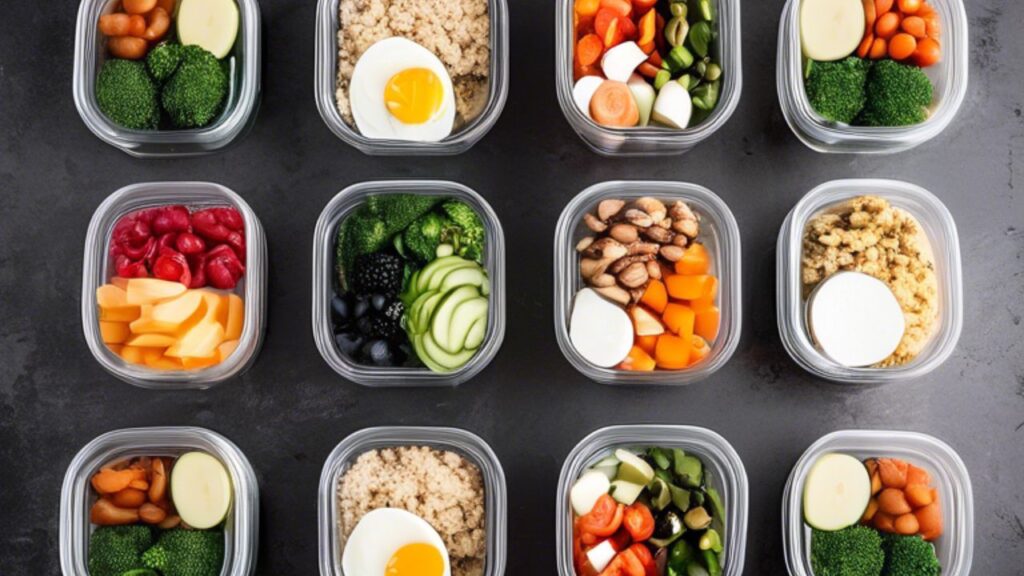
Navigating challenges in meal prep is essential to sustaining a long-term meal prep routine. This section addresses common challenges such as repetition and boredom in meal prep. It provides practical solutions and creative ideas to keep your meals interesting and varied. Strategies may include incorporating different flavors, spices, and ingredients, trying new recipes and cuisines, and exploring meal prep resources for inspiration.
One solution to overcome the challenge of repetition and boredom is to experiment with different flavors, spices, and ingredients. By adding new and exciting ingredients to your meal prep recipes, you can transform your meals and make them more interesting. Try incorporating herbs, spices, or sauces that you haven’t used before to create unique flavor combinations. This not only adds variety but also keeps your taste buds engaged.
Another way to overcome boredom in meal prep is to try new recipes and cuisines. Step out of your comfort zone and explore different culinary traditions. You may discover new favorite dishes that you can incorporate into your meal prep rotation. Online recipe databases, cooking blogs, and meal prep cookbooks are great resources for finding inspiration and trying new recipes.
Adapting meal prep to different dietary needs is also important for those with specific dietary restrictions or preferences. This section provides guidance on tailoring meal prep recipes to accommodate various diets, such as vegetarian, vegan, gluten-free, or dairy-free.
By understanding the dietary restrictions and preferences of yourself or your family members, you can modify recipes and choose ingredients that align with those needs. There are many resources available that offer meal prep ideas and recipes specifically designed for different dietary requirements.
By addressing these challenges and offering practical solutions, you can overcome barriers and maintain a successful and enjoyable meal prep routine. Don’t let repetition or dietary restrictions discourage you.
Embrace the opportunity to get creative, try new flavors, and explore different cuisines. With a little planning and innovation, meal prep can continue to be a rewarding and satisfying experience.
Conclusion
In conclusion, budget friendly meal prep is a valuable tool for saving money, time, and promoting healthy eating habits. By understanding the basics of meal prepping, creating a budget-friendly meal plan, evaluating and purchasing the right containers, adopting smart grocery shopping strategies, and mastering efficient cooking techniques, you can achieve your meal prep goals.
Recipe ideas, time management strategies, and tips for getting started provide practical guidance for beginners. Challenges and solutions in meal prep help navigate common obstacles and adapt to different dietary needs.
By implementing these strategies and incorporating budget-friendly meal prep into your routine, you can enjoy delicious and nutritious meals while staying on track with your budget. Happy meal prepping!
If you are looking for more information, check out this article on meal prep for beginners.
FAQ
What is meal prepping and why should I do it?
Meal prepping involves preparing meals or recipes in advance and portioning them out for future consumption. It can save time, money, and reduce food waste, making it a beneficial practice for many individuals.
What are the benefits of meal prepping?
Meal prepping has several benefits, including saving time in the kitchen, reducing the temptation to eat out, promoting healthier eating habits, and helping to manage weight. It also allows for portion control and ensures that you have healthy, budget-friendly meals readily available.
How do I identify my meal prep style and goals?
Consider your personal preferences, lifestyle, and goals when it comes to meal prepping. Do you want to prep all your meals for the week or just certain meals or ingredients? Knowing your goals, such as saving money, eating healthier, or having more time during the week, will help guide your meal prepping strategy.
How can I create a budget-friendly meal plan?
Start by determining how many meals you need to prepare and what types of meals you want to include. Consider incorporating affordable ingredients, seasonal produce, and items that are on sale or in bulk. Aim for a balanced meal plan that includes a variety of nutrients and flavors.
What are some affordable meal prep container options?
When starting out, consider budget-friendly container options such as reusable plastic Ziploc containers. As your budget allows, you can graduate to more sustainable and durable solutions like glass containers. Metal bento-style containers are also great for cold meals that don’t require reheating.
How can I save money on groceries for meal prep?
Plan your meals and create a comprehensive grocery list based on your meal plan. Look for sales, discounts, and coupons to save money. Consider shopping at budget-friendly stores like Aldi or Trader Joe’s and buying generic or store-brand products. Purchasing in bulk for frequently used ingredients can also save money in the long run.
What are some recipe ideas for budget-friendly meal prep?
For breakfast, consider options like overnight oats, egg muffin cups, or smoothie packs. For lunch, packable options like wraps, salads, or grain bowls are cost-effective. Dinner solutions can include stir-fries, casseroles, or one-pot dishes. Focus on using affordable ingredients like grains, beans, seasonal vegetables, and lean proteins.
What are some efficient cooking techniques for meal prep?
Batch cooking is a popular method that involves cooking larger quantities of food at once. Utilizing leftovers wisely can also help save time. For example, repurpose leftover roasted chicken into sandwiches, salads, or stir-fries.
How should I store and preserve my prepped meals?
Invest in high-quality meal prep containers that are airtight and leak-proof to keep your meals fresh. Follow FDA guidelines for refrigeration if storing in the refrigerator. Freeze meals if you won’t be consuming them within a few days to extend their shelf life.
How can I manage my time effectively for meal prep?
Create an effective meal prep schedule that works for your lifestyle and schedule. Set aside dedicated time each week to plan, shop, prep ingredients, and cook. Use time-saving techniques like multitasking, utilizing kitchen gadgets, and prepping ingredients in advance.
What tips do you have for beginners starting with budget-friendly meal prep?
Start small and gradually increase your meal prep efforts. Set realistic expectations and experiment with simple and inexpensive meal ideas. Building confidence and honing basic meal prep skills is key to long-term success.
How can I overcome challenges and adapt meal prep to different dietary needs?
To overcome repetition and boredom, incorporate different flavors, spices, and ingredients. For different dietary needs, modify recipes to accommodate vegetarian, vegan, gluten-free, or dairy-free diets. Utilize resources for inspiration and try new recipes and cuisines.

Jim Lopez, the founder and editor of The Meal Prep Ninja, shares his journey from a passionate bodybuilder and fitness enthusiast to a certified nutrition coach. Certified by Precision Nutrition, Jim aims to empower others with knowledge on meal prep and nutrition, offering resources for busy individuals to enjoy low-calorie, tasty foods. His blog is a community for sharing healthy eating habits and meal prep recipes
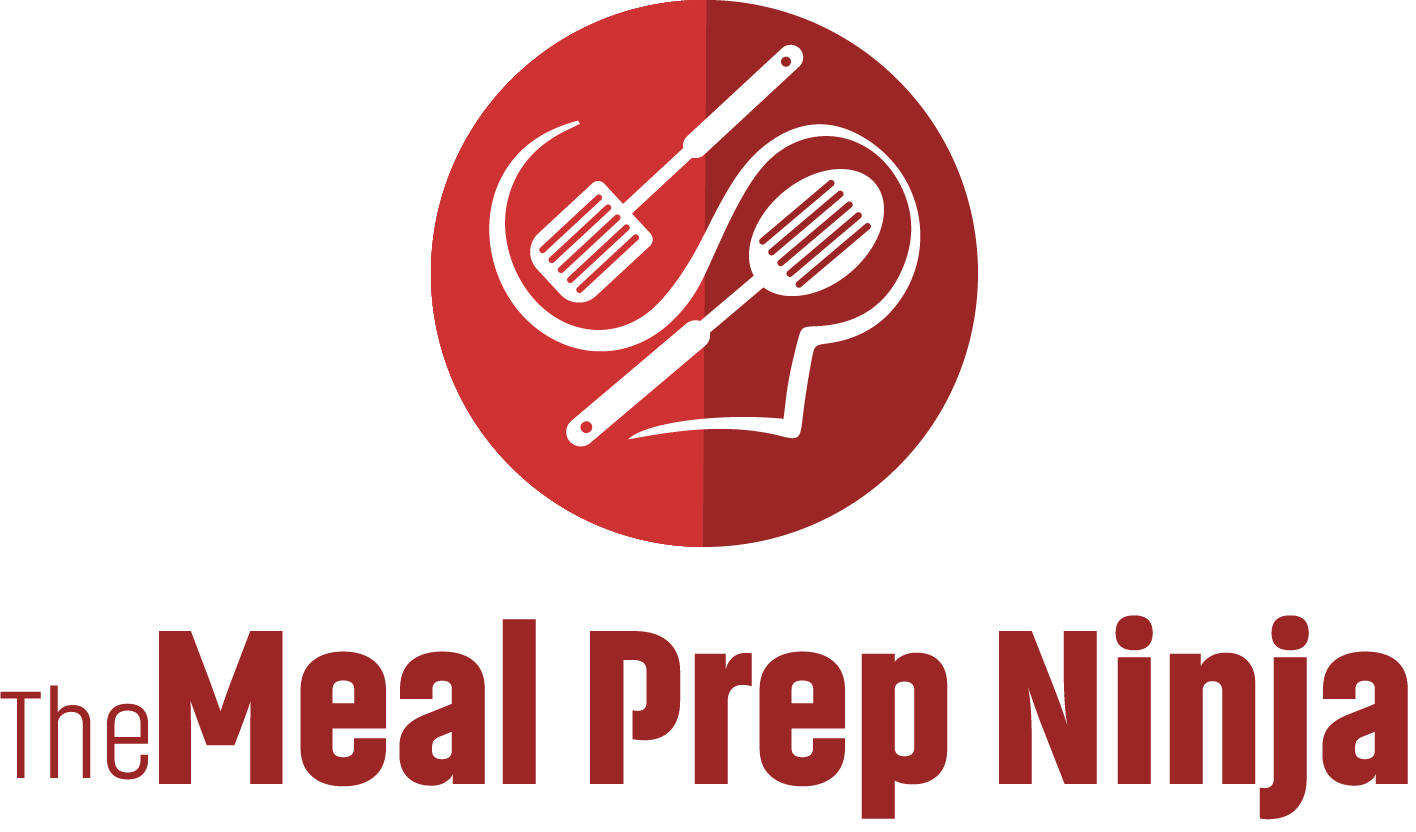
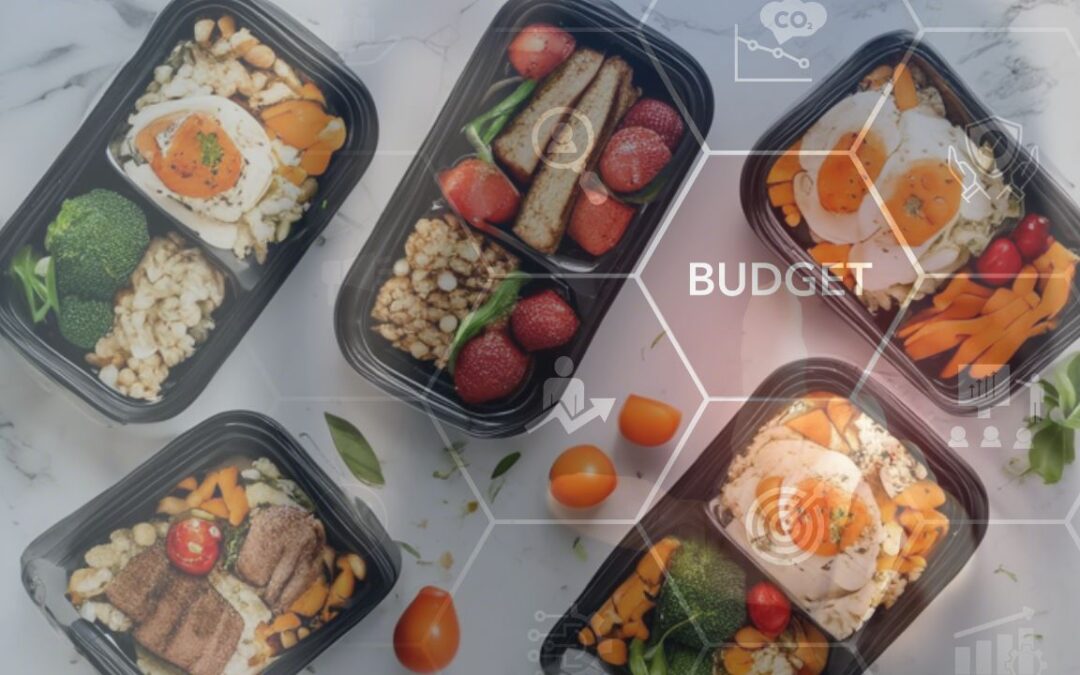

![Freshware Meal Prep Containers [50 Pack] 1 Compartment with Lids, Food Storage Containers, Bento Box, BPA Free, Stackable, Microwave/Dishwasher/Freezer Safe (28 oz)](https://m.media-amazon.com/images/I/5100woitKcL._SL160_.jpg)


